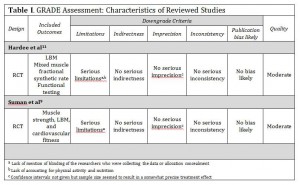The Effects of a High Intensity Aerobic and Resistance Exercise Program on Lean Body Mass and Strength in Pediatric Victims with Severe Burn Injury
ABSTRACT
Background: Severe burn injuries affect thousands of individuals each year, 30% of whom are individuals under the age of 16. The impact of severe burn injuries on physiological function is dramatic in survivors. It induces a surge of circulating pro inflammatory cytokines, catecholamines, and glucocorticoids, which perpetuate a prolonged stress response that wreaks havoc in the body. This process often results in difficulty with functional abilities and a decreased quality of life for severe burn victims. Re-integration into society is quite difficult for this population, and they become at risk for long term health consequences. Generally, high intensity aerobic and resistance exercise therapy has proven to be beneficial in adults regarding lean body mass, strength, and cardiorespiratory endurance. Would these benefits carry over to pediatric burn patients?
Methods: An exhaustive medical literature search was performed using MEDLINE-Ovid, MEDLINE-PubMed, Google Scholar, Web of Science using the keywords: burn or burns, pediatric or children, and exercise. The references of these were reviewed for relevant studies. The included articles were assessed for quality utilizing the Grading of Recommendations, Assessment, Development, and Evaluation (GRADE).
Results: Two articles met the eligibility criteria, both of which were randomized control trials. The two studies examined very similar primary and secondary outcomes, with the only major difference being the timeframe in which the pediatric burn patients began the exercise intervention. The results were very consistent between the two, both showing a significant improvement in strength and lean body mass. The overall quality of the original studies are moderate due to some limitations. Further studies can minimize these limitations and further elucidate what is known in regards to the effect of a high intensity aerobic and resistance exercise intervention in pediatric burn victims.
Conclusion: The studies examining the effect of an exercise program in addition to a standard rehabilitation program provide enough evidence to support its recommendation. However, further research is required to determine the extent of the effect of exercise in these patients and the most beneficial exercise regimen, in addition to how it affects direct measures of re-integration into society and long-term health outcomes.
Keywords: Burns, children, and exercise.
(Click on image to enlarge.)
REVIEWED STUDIES:
Hardee JP, Porter, C, Sidossis LS, Borsheim E, Carson JA, Herndon DN, Suman OE. Early rehabilitative exercise training in the recovery from pediatric burn. Med Sci Sports Exerc. 2014;46(9):1710-6.
Suman, OE, Spies, RJ, Celis, MM, Mlcak, RP, Herndon DN. Effects of a 12-wk resistance exercise program on skeletal muscle strength in children with burn injuries.
AUTHOR: Kari Anna Hultgren is currently completing her second year in the School of PA Studies at Pacific University, Oregon. She will graduate with an MS degree in August, 2016.

No Comments Yet